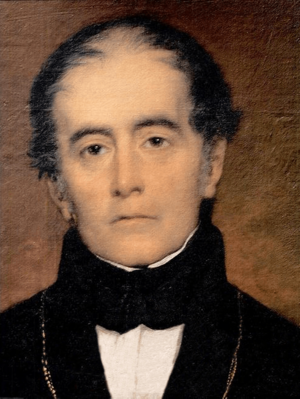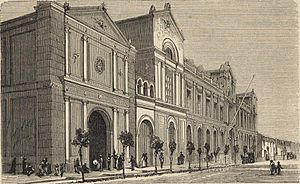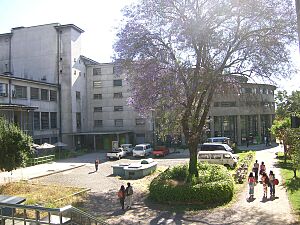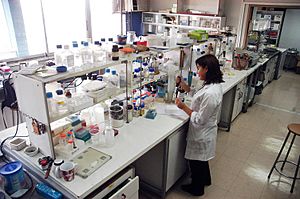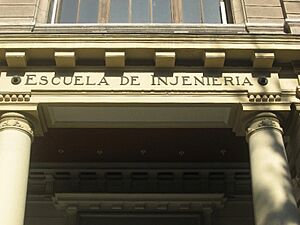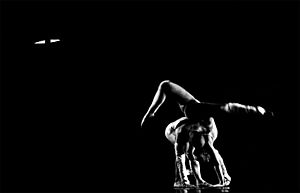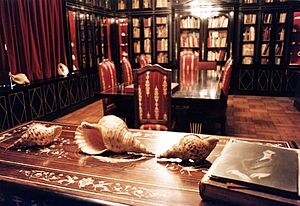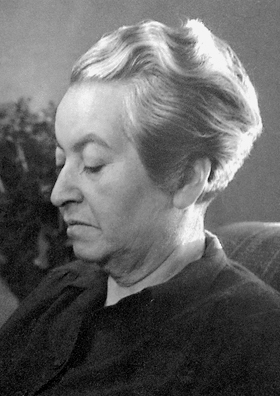University of Chile facts for kids
|
Universidad de Chile
|
|
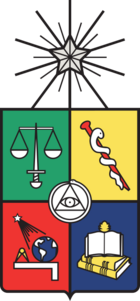 |
|
| Motto | Donde todas las verdades se tocan |
|---|---|
|
Motto in English
|
"Where all truths touch" |
| Type | Public |
| Established | July 28, 1738 (as the Royal University of San Felipe) November 19, 1842 (re-establishment) |
|
Academic affiliation
|
McDonnell International Scholars Academy |
| President | Rosa Devés Alessandri |
|
Academic staff
|
3,675 |
| Students | 43,779 |
| Undergraduates | 33,910 |
| Postgraduates | 9,869 |
| Location | , , |
| Campus | Campus Andrés Bello Campus Beauchef Campus Juan Gómez Millas Campus Dra. Eloísa Díaz Campus Sur |
| Mascot | Chuncho (Austral pygmy owl) |
The University of Chile (in Spanish: Universidad de Chile) is a big public school in Santiago, Chile. It was started on November 19, 1842. The university officially opened on September 17, 1843. It is the oldest university in Chile.
This university is known for its history in learning, science, and helping the community. It aims to solve problems in Chile and help the country grow. Many people see it as one of the best universities in Latin America. This is because it leads the way in science, technology, social studies, and arts. It is considered the most important and respected university in Chile.
Its five main areas, called campuses, cover a lot of space. They have buildings for research, health centers, museums, theaters, and sports fields. The university has over 40,000 students. It offers more than 60 different bachelor's degrees and professional programs. It also has many advanced programs, like 38 doctoral degrees and 116 master's degrees.
Many famous people have studied here. This includes Nobel Prize winners Pablo Neruda and Gabriela Mistral. Twenty-one Chilean presidents, including the current president Gabriel Boric, also studied at this university. Two presidents from other countries (Mexico and Ecuador) are also alumni.
Contents
University Rankings and Quality
| University rankings | |
|---|---|
| Global – Overall | |
| ARWU World | 401-500 (2022) |
| CWUR World | 438 (2023) |
| CWTS World | 482 (2023) |
| QS World | =173 (2026) |
| THE World | 1001–1200 (2023) |
| USNWR Global | 400 (2022-23) |
| Regional – Overall | |
| QS Latin America | 3 (2023) |
| THE Latin America | 9 (2020) |
| USNWR Latin America | 4 (2022-23) |
The University of Chile is highly ranked among universities worldwide. For example, the QS University Ranking placed it as 139th in the world for the year 2025. This ranking looks at things like how well-known the university is among other schools and employers. The University of Chile scored very high in both these areas.
Another important ranking, the Shanghai JiaoTong University ranking, puts it among the top 400 universities globally. This ranking focuses on scientific research. The SCImago Institutions Rankings (SIR) also recognized the university as first in Chile and 10th in Latin America in 2017.
The Ranking Web of Universities measures how much presence and impact universities have online. It ranked the University of Chile as the leader in Chile and sixth in Latin America. In 2016, a ranking by AméricaEconomía also placed it first in Chile. This was due to its high quality in research, accreditation, facilities, and inclusion.
Accreditation Status
On December 21, 2011, the University of Chile received a great review from the National Accreditation Commission (CNA). It was given the highest possible accreditation for seven years, lasting until 2018. This means the university meets very high standards in all its important areas. These areas include how it is managed, how it teaches students, its research, and how it connects with the community.
The University of Chile is one of only a few universities in the country with this top accreditation. Other universities with this high rating include the Catholic University and the University of Santiago.
University History
In 1841, a government minister named Manuel Montt had an idea. He wanted to create a group to help science and humanities grow. Andrés Bello, a famous writer and thinker from Venezuela, created the plan. This plan became a law on November 19, 1842, and the University of Chile was born.
The university was created to help Chile become a modern country. Chile had become independent from Spain just a few decades before. The new university took the place of an older school, the Royal University of San Felipe, which started in 1738.
The university officially opened on September 17, 1843. In its early years, it had five main study areas: Humanities & Philosophy, Physical & Mathematical Sciences, Law & Political Sciences, Medicine, and Theology. The university played a big role in improving education and helping to organize the country. It also helped build roads and energy systems.
By 1931, the university had grown to six colleges. These included Philosophy & Education Sciences, Legal & Social Sciences, and Biology & Medical Sciences. The university has also helped train many of Chile's leaders and thinkers. Most Chilean presidents have studied there, along with many important people in politics, business, and culture.
Changes During the Military Government (1973–1989)
During a period of military government in Chile from 1973 to 1989, the university went through many big changes. In October 1973, a new rule said that the university's leaders would be chosen by the military government.
Another major change happened in January 1981. A new rule completely reorganized the university. All of its campuses outside the main city were separated. They joined with other schools to become new, separate universities. For example, the campus in Talca became the Universidad de Talca.
These changes were made to reduce the university's influence on the country's politics and ideas. Even with these big changes, the University of Chile is still seen as the most respected university in Chile. It is known for its research, the number of students who want to attend, and its impact on society.
How the University is Organized
The University of Chile works with teachers, students, and staff. They all work together to achieve the university's goals.
University Leadership
- President (Rector): This is the highest leader and legal representative of the university. The president is chosen by the most experienced teachers. Since 2022, the president is Rosa Devés Alessandri.
- Assistant President (Prorrector): This person helps the President with many things. They advise on school matters, money, rules, and student issues. They also help coordinate the different Vice Presidencies.
- University Council (Consejo Universitario): This group approves important decisions. It includes the president, vice deans, and two people chosen by the country's president.
- Evaluation Council (Consejo de Evaluación): This group makes sure that all evaluations and accreditations are done correctly.
- University Senate (Senado Universitario): This group is led by the president and has 36 members. These members include 27 teachers, 7 students, and 2 staff representatives.
Vice Presidencies
The University of Chile has six main departments that help run things. They are called Vice Presidencies (Vicerrectorías):
- Academic Affairs (for teaching and learning)
- Financial and Institutional Management Affairs (for money and running the university)
- Information Technologies (for computers and tech)
- Public Engagement and Communication (for connecting with the public)
- Research and Development (for new discoveries)
- Student and Community Affairs (for students and campus life)
Schools and Institutes
The university has 19 different schools (called faculties) and four special institutes. These places handle all the teaching, research, and community work.
- Faculty of Agricultural Sciences
- Faculty of Architecture and Urbanism
- Faculty of Arts
- Faculty of Chemical Sciences and Pharmacy
- Faculty of Communications and Image
- Faculty of Dentistry
- Faculty of Economy and Business
- Faculty of Forestry Sciences
- Faculty of Government
- Faculty of Law
- Faculty of Medicine
- Faculty of Philosophy and Humanities
- Faculty of Physical and Mathematical Sciences
- Faculty of Sciences
- Faculty of Social Sciences
- Faculty of Veterinary and Animal Sciences
- Institute of Advanced Studies in Education
- Institute of International Studies
- Institute of Nutrition and Food Technology
What Students Learn
The University of Chile offers many different study programs. These programs cover all kinds of subjects. The quality of these programs has been highly praised by the National Accreditation Commission.
Undergraduate Programs
The university has 69 study programs for undergraduate students. Most of these lead to professional degrees. Students can get into these programs by taking a special test or through the Academic Bachelor's Program. The university also has special ways for certain students to get in. This includes talented athletes, blind students, students who studied in other countries, and students from certain ethnic groups.
Since 2012, the university has a special admission program called SIPEE. This program helps students from public schools get into programs. Also, since 2014, the Faculty of Physical and Mathematical Sciences has a program for girls. It helps the first 40 female applicants on the waiting list get a spot.
Graduate Programs
The University of Chile has the largest and most complex system for advanced studies in Chile. It offers 36 doctoral programs, 116 master's programs, and many other specialized courses.
Research and Discoveries
The University of Chile is the top institution in Chile for scientific and technological research. It is responsible for a large part of the scientific papers published in Chile. It also leads many research projects in various fields. These fields include basic sciences, technology, humanities, social sciences, and arts.
- Publications: From 2010 to 2016, the university published over 12,000 scientific papers in international journals.
- Research Projects: In 2016, it had 105 projects funded by the National Fund for Science & Technology Development.
- Millennium Institutes: The university has 4 special institutes focused on big topics like ecology and engineering.
- Millennium Nuclei: It also has 5 smaller research groups called Nuclei, focused on sciences.
- Special Centers: The university has 7 centers that focus on important areas like math, astrophysics, and biology.
- Research Rings: It leads 6 projects that bring together three or more research groups.
Applied Research Projects
The university also works on projects that solve real-world problems.
- FONDEF Projects: It has 30 ongoing projects in areas like education, health, engineering, and agriculture.
- Innova Projects: In 2016, it had 34 projects funded by CORFO. These projects focused on areas like agriculture, tourism, and biotechnology.
Campuses and Buildings
The university owns a lot of land and buildings. It has over 3 million square meters of urban land and many buildings.
University Campuses
The university has five main campuses, all located in the Santiago area.
- Juan Gómez Millas Campus: This campus is in Ñuñoa. It is home to the schools of Arts, Sciences, Social Sciences, Philosophy and Humanities, and Communication and Image. It is currently being updated with new buildings and parks.
- Beauchef Campus: The Faculty of Physical and Mathematical Sciences has been on this campus since 1922. A new building opened in 2014, adding lots of space for offices, auditoriums, sports, and parking.
- South Campus: This campus was established in 1999 and covers a very large area. It includes the schools of Veterinary and Animal Sciences, Agricultural Sciences, and Forestry Science. It also has the Institute of Nutrition and Food Technology (INTA).
- Andrés Bello Campus: This campus is in downtown Santiago. It has some of the oldest and most famous university buildings, like the Faculty of Law and the Faculty of Architecture and Urbanism.
- North Campus: Located in Independence, this campus is a major center for health research and training. It houses the schools of Chemical Sciences and Pharmacy, Medicine, and Dentistry. It also has the University of Chile Clinic Hospital.
Main House
The university's main building, known as the Main House, opened in 1872. It has a beautiful old design and is located in downtown Santiago.
Libraries and Digital Resources
The university's libraries have over 3 million books, journals, and other materials. These are available in 48 different libraries across the university. There are many reading spaces and computers for students and staff. The Digital Library offers access to over 50 million online documents. These include books, theses, articles, and historical items like maps and photos.
The university's online publications are free to access. You can find them through its institutional website, academic journals, and e-book portal.
Culture and Arts
The university helps share culture and arts through its performance groups, museums, and theaters.
Performing Arts
- National Chilean Ballet – BANCH
- Chile Symphony Orchestra
- Chile Symphony Choir
- Vocal Camerata
- Antumapu Folkloric Ballet
- Chilean National Theater
Museums and Galleries
- Museum of Contemporary Art
- Museum of American Popular Art
- Juan Egenau Exhibit Hall
- National Museum of Medicina
- Pharmacy Museum
- Dentistry Museum
Theaters
- University of Chile Theater
- Antonio Varas Theater
- Agustín Siré Hall
- Sergio Aguirre Hall
- Isidora Zegers Concert Hall
- Master Study Hall
- Cineteca
Interesting Facts
- Founded in 1842, it is the oldest higher education institution in Chile.
- The first woman in South America to become a doctor, Eloísa Díaz Insunza, graduated from the University of Chile in 1887.
- Many other "first women" in different fields also graduated here. This includes the first woman lawyer (Matilde Throup, 1892) and the first woman engineer (Justicia Espada, 1919).
- In 1906, the University of Chile Student Federation (FECH) was founded. It is the first and oldest student organization in Chile.
- In 1922, Amanda Labarca became the first woman professor at the Faculty of Humanities.
- Both of Chile's Nobel Prize winners are connected to this university. Gabriela Mistral received an honorary degree in 1954. Pablo Neruda studied there and later received an academic honor. He also donated his library and shell collection to the university.
- The first kidney transplant in Chile was performed at the university's Clinical Hospital in 1966.
- The first weather satellite image of Chile was received at the university in 1966.
- The first email in Chile was sent from the university in 1985.
- In 1987, the university registered the first internet domain in Chile: www.uchile.cl.
- In 2007, students from the Faculty of Physical and Mathematical Sciences built the Eolian. This was the first Chilean solar car.
- Research on supernovae by the Department of Astronomy helped lead to a Nobel Prize in Physics in 2011.
- A large number of Chilean National Award winners (172 out of 207) were graduates, teachers, or students of the University of Chile.
- The University of Chile has the highest possible accreditation in Chile, along with the Pontificia Universidad Católica de Chile.
- It is responsible for 37% of Chile's scientific journals that meet international standards.
Related Organizations and Services
The University of Chile manages many important services and organizations across the country:
- The National Astronomical Observatory, which has been working since 1852.
- The Contemporary Art Museum (MAC).
- Research efforts in Antarctica, since 1940.
- The official service for studying earthquakes and watching volcanoes, since 1908.
- Chile's Symphonic Orchestra, since 1941.
- Chile's National Ballet, since 1945.
- Symphonic Chorus, since 1945.
- Centers for studying Greek, Arabic, and Jewish cultures.
- The largest Clinical Hospital in the country.
- The Institute for Easter Island Studies.
- The Center for Mathematical Modeling (CMM).
- The Centre for Space-related Studies, which works with NASA and other international groups.
- The Universidad de Chile Theatre.
- The Institute of Public Affairs (INAP).
- The Nutrition and Food technology Institute (INTA).
- The Museum of Popular American Art, since 1947.
- The Chile's NIC, which manages internet domains for Chile.
- The Institute for Experimentation and Research of Materials (IDIEM).
There are more than twenty other important centers connected to the university.
Famous Alumni
Many important Chilean leaders and thinkers have studied or worked at this university. This includes 21 presidents of Chile, 3 presidents of other Latin American countries, and 172 Chilean National Award winners.
Nobel Winners
- Federico Errázuriz Zañartu
- Aníbal Pinto Garmendia
- Domingo Santa María
- Federico Errázuriz Echaurren
- Germán Riesco Errázuriz
- Pedro Montt Montt
- Ramón Barros Luco
- Juan Luis Sanfuentes
- Arturo Alessandri Palma
- Luis Barros Borgoño
- Emiliano Figueroa Larraín
- Juan Esteban Montero
- Pedro Aguirre Cerda
- Gabriel González Videla
- Jorge Alessandri Rodríguez
- Salvador Allende Gossens
- Patricio Aylwin Azócar
- Eduardo Frei Ruiz-Tagle
- Ricardo Lagos Escobar
- Michelle Bachelet Jeria
- Gabriel Boric Font
Presidents of Other Countries
- José López Portillo (México)
- Camilo Ponce Enríquez (Ecuador)
Other Notable People
- Francisco Aboitiz, neuroscientist
- Jorge H. Capdevila, biochemist
- Daniel Farcas, Chilean deputy
- Alejandro Jodorowsky, filmmaker (did not finish his studies)
Notable Professors
- Arturo Arias (engineer) (Anti-earthquake engineering)
- Thomas Barthel (Study of cultures and ancient writings)
- Andrés Bello (Laws and Humanities)
- Ignacy Domeyko (Geology)
- Celso Garrido Lecca (Music)
- Humberto Giannini (Philosophy)
- Andre Gunder Frank (Sociology and Economic History)
- Richard Gott (International Affairs)
- Lola Hoffmann (Psychiatry and Psychology)
- Louis Lliboutry (Study of glaciers)
- Cinna Lomnitz (Study of earthquakes, Earth's physics, and rock behavior)
- Eugenio María de Hostos (Laws, Education and Humanities)
- Ignacio Matte Blanco (Psychiatry)
- Humberto Maturana (Biology and Philosophy)
- Aron Mosnaim (Neuroscience)
- Claudio Naranjo (Psychiatry and Psychology)
- Theotônio dos Santos (Economics)
- Domingo Faustino Sarmiento (Education and Humanities)
- Albert Schatz (scientist) (Microbiology and Science Education)
- Alain Touraine (Sociology)
- Max Westenhöfer (Study of diseases and Biology)
- Roberto Donoso-Barros (Biology and Herpetology - study of reptiles and amphibians)
- Jean Gustave Courcelle-Seneuil (Economics)
Important Facts About the University
- Founded in 1842, it is the oldest university in Chile.
- The first woman to attend university in South America studied here. Eloísa Díaz Insunza became a doctor in 1887.
- Many other "first women" in different fields graduated from this university. This includes the first woman lawyer (Matilde Throup, 1892) and the first woman engineer (Justicia Espada, 1919).
- In 1906, the University of Chile Student Federation (FECH) was founded. It is the first and oldest student organization in Chile.
- Amanda Labarca was named the first woman academician here in 1922.
- Chile's two Nobel Prize winners are connected to this university. Gabriela Mistral received an honorary title in 1923. Pablo Neruda studied here and later received an academic honor. He also donated his library and shell collection to the university.
- The first renal transplantation (kidney transplant) in Chile happened at its Clinical Hospital in 1966.
- The first weather satellite image of Chile was received at the university in 1966.
- The first email from Chile was sent from the university in 1985.
- In 1987, the university registered the first internet domain in Chile: www.uchile.cl.
- It was the first university in Chile to have a senate, starting in 2006.
- In 2007, students built the Eolian. This was the first Chilean solar car.
- Research on supernovae from the Astronomy Department helped a scientist win the Nobel Prize in Physics in 2011.
- Many National Award winners in Chile have been connected to the university.
- The university has the highest possible accreditation in Chile.
- It is responsible for 37% of Chilean scientific journals.
See also
 In Spanish: Universidad de Chile para niños
In Spanish: Universidad de Chile para niños
- Notable alumni of the University of Chile
- University of Chile Student Federation (FECH)


